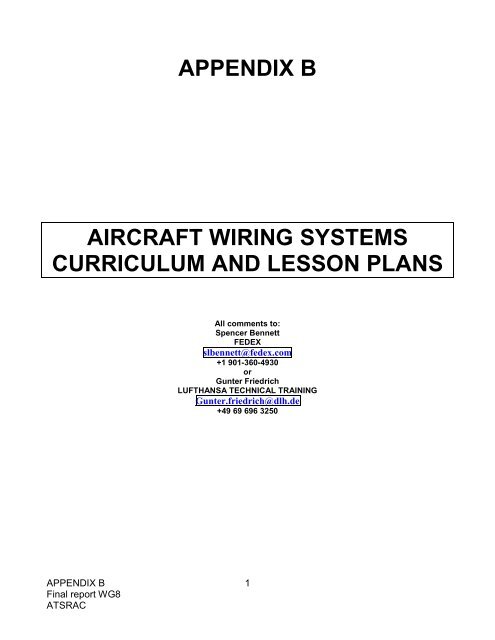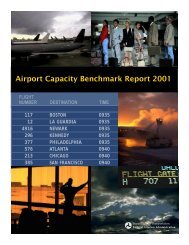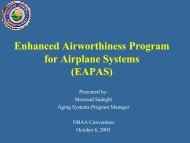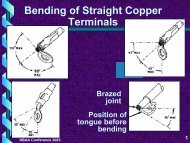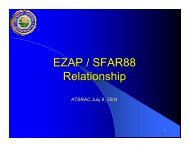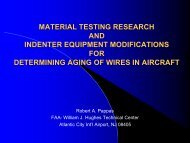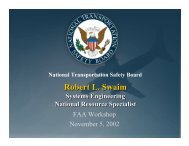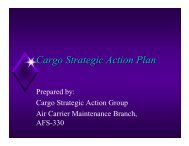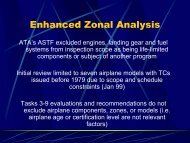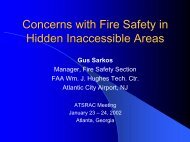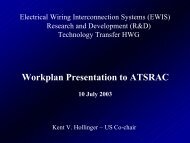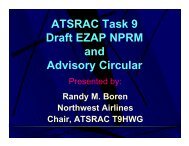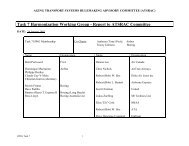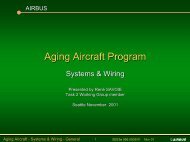APPENDIX B AIRCRAFT WIRING SYSTEMS CURRICULUM AND LESSON PLANS
January 2002 - Task 8 Draft AC Appendix B
January 2002 - Task 8 Draft AC Appendix B
You also want an ePaper? Increase the reach of your titles
YUMPU automatically turns print PDFs into web optimized ePapers that Google loves.
<strong>APPENDIX</strong> B<strong>AIRCRAFT</strong> <strong>WIRING</strong> <strong>SYSTEMS</strong><strong>CURRICULUM</strong> <strong>AND</strong> <strong>LESSON</strong> <strong>PLANS</strong>All comments to:Spencer BennettFEDEXslbennett@fedex.com+1 901-360-4930orGunter FriedrichLUFTHANSA TECHNICAL TRAININGGunter.friedrich@dlh.de+49 69 696 3250<strong>APPENDIX</strong> BFinal report WG8ATSRAC1
TABLE OF CONTENTS<strong>WIRING</strong> SYSTEM <strong>CURRICULUM</strong>....................................................................................<strong>WIRING</strong> <strong>SYSTEMS</strong> <strong>LESSON</strong> PLAN................................................................................MODULE A – INTRODUCTION...........................................................................MODULE B – <strong>WIRING</strong> PRACTICES DOCUMENTATION...................................MODULE C – INSPECTION.................................................................................MODULE D – HOUSEKEEPING..........................................................................MODULE E – WIRE.............................................................................................MODULE F – CONNECTIVE DEVICES...............................................................MODULE G – CONNECTIVE DEVICE REPAIR..................................................355789111314<strong>APPENDIX</strong> BFinal report WG8ATSRAC2
AGING TRANSPORT <strong>SYSTEMS</strong> RULEMAKING ADVISORY COMMITTEE (ATSRAC)<strong>CURRICULUM</strong> <strong>AND</strong> <strong>LESSON</strong> <strong>PLANS</strong><strong>WIRING</strong> <strong>SYSTEMS</strong><strong>CURRICULUM</strong>OverviewThis training is targeted to the person who performs airplane maintenance, inspections, alterations orrepairs on structure and/or wiring systems. After training the person is able to properly evaluate the wiringsystem and effectively use the manufacturers Chapter 20 Wiring System overhaul manual for that airplane. Thismust include; wiring system condition, applicable repair schemes, wiring modifications and ancillary repairs towiring systems and components. All of the training components are integrated to maintain wiring system qualityand airworthiness in the airplane.ObjectivesDepending on the modules taught, the person demonstrates competency in the following skills:A. Demonstrate the safe handling of airplane electrical systems, Line Replaceable Units (LRU's),tooling, troubleshooting procedures, and electrical measurement.B. Know the construction and navigation of the applicable airplane wiring system overhaul or wiringpractices manualC. Know the different types of inspections, human factors in inspections, zonal areas and typicaldamages.D. Know the contamination sources, materials, cleaning and protection procedures.E. Demonstrate the correct identification of different wire types, their inspection criteria, and damagetolerance, repair and preventative maintenance procedures.F. Know the procedures to identify, inspect and find the correct repair for typical types of connectivedevices found on the person's airplane.G. Demonstrate the procedures for replacement of all parts of typical types of connective devicesfound on the person's airplane.ScopeThe course is to be used by training providers for all maintenance persons at any stage in their careers.The person can be trained to the appropriate level using the applicable modules, depending the personsexperience, work assignment and operators policy. The time stated for each module is a minimum.MODULE A – INTRODUCTION: 4 hours<strong>APPENDIX</strong> BFinal report WG8ATSRAC1. Safety practices2. Electrostatic Discharge Sensitive (ESDS) Device handling and protection3. Tools, special tools and equipment4. Verify calibration/certification of instruments, tools, and equipment5. Required wiring checks using the Troubleshooting Procedures and Charts (incl. NoFault Found Data)6. Measurement and troubleshooting using meters.7. LRU replacement general practices3
MODULE B – <strong>WIRING</strong> PRACTICES DOCUMENTATION: 5 hours1. Chapter 20 structure/overview2. Chapter 20 cross-reference Index3. Chapter 20 important Data and Tables4. Wiring Diagram Manual5. Other Documentation as applicableMODULE C – INSPECTION: 3 hours1. General Visual Inspection (GVI), Detailed Inspection (DI) and Special DetailedInspection (SDI), Zonal Inspection, Enhanced Zonal Analysis Procedure (EZAP)2. Human factors in inspection3. Zonal areas of inspection4. Wiring system damageMODULE D – HOUSEKEEPING: 3 hours1. Airplane external contamination sources2. Airplane internal contamination sources3. Other contamination sources4. Contamination protection planning5. Protection during airplane maintenance and repair6. Cleaning processesMODULE E – WIRE: 6 hours1. Identification, type and construction2. Insulation damage limits3. Inspection criteria and standards of wire and wire bundles4. Wire bundle installation practices5. Typical damage and areas found (airplane specific)6. Maintenance and repair procedures7. Sleeving8. Unused wires-termination and storage9. Electrical bonding and groundsMODULE F – CONNECTIVE DEVICES: 3 hours1. General types and identification2. Cautions and protections3. Visual inspection procedures4. Typical damage found5. Repair proceduresMODULE G – CONNECTIVE DEVICE REPAIR: 6 hours<strong>APPENDIX</strong> BFinal report WG8ATSRAC1. Circular Connectors2. Rectangular Connectors3. Terminal Blocks-Modular4
4. Terminal Blocks- Non-modular5. Grounding Modules6. Pressure Seals<strong>WIRING</strong> <strong>SYSTEMS</strong> <strong>LESSON</strong> PLANMODULE A: INTRODUCTIONOverviewThrough Module A, the instructor lays the groundwork of safe effective maintenance and repair of theairplane wiring systems and LRU removal and replacement, including BITE, without damage to the airplane orinjury to the student.The Instructor may vary the depth and scope of the topics to be covered, depending on the type of airplane tobe maintained and skills of the persons.ObjectivesAfter this module is complete the student is able to demonstrate the following skills:1. Know the safety procedures of normal and non-normal maintenance procedures so the person canprotect him/herself and the airplane.2. Recognize ESDS equipment and demonstrate standard anti-static procedures so that no damageoccurs to that equipment.3. Demonstrate the correct use of hand tools including specialized and automated tools andequipment.4. Verify the calibration of electrical measuring instruments, tools and equipment so that correctmaintenance procedures may be carried out.5. Demonstrate the process and procedures to successfully use the Troubleshooting Procedures andcharts of current airplane faults and know re-occurring problems causing “No Fault Found” onremoved LRU’s.6. Demonstrate the correct use of electrical meters for measuring voltage, current, resistance,continuity, insulation and short to ground.7. Know the removal and replacement techniques so that no damage will occur to the LRU or airplaneconnector.StrategiesNormal classroom lecture is used for the majority of the training. The following strategies can be usedto expedite learning and are recommended to the instructor.Electrostatic Discharge Sensitive (ESDS) Device handling and protection……Video/Training AidsCalibration/certification of instruments, tools, and equipment………….………..Company PolicyWiring checks using the Troubleshooting Procedures and Charts……………..Airplane manualsMeasurement and troubleshooting using meters………………….……………...Meters and circuitsLRU removal and replacement………………………………………………………Airplane manualsMODULE A - INTRODUCTION:<strong>APPENDIX</strong> BFinal report WG8ATSRAC1. Safety practicesa. Current is lethal - First aidb. Applying power to the airplane5
c. Isolating the circuitd. Airplane warningse. Human Factors2. Electrostatic Discharge Sensitive (ESDS) Device handling and protectiona. Sources of electrostatic dischargeb. Soft and hard failuresc. ESDS safety proceduresd. ESDS packing procedures3. Tools, special tools and equipmenta. General hand toolsb. Specialized toolsc. Automated tools and equipment4. Verify calibration/certification of instruments, tools and equipmenta. Tools requiring certificationb. Determining certification requirementsc. Typical problems5. Required wiring checks using the Troubleshooting Procedures and Charts and “No FaultFound”.a. Troubleshooting procedures manual (all chapters)b. Aircraft Maintenance Manual/ Illustrated Parts Catalogc. Wiring schematics / Troubleshooting graphicsd. Wiring diagramse. The process of troubleshootingf. Testing of LRU connectorsg. Troubleshooting exercisesh. Company “No Fault Found” policy and data6. Measurement and troubleshooting using metersa. Voltage, current and resistanceb. Continuityc. Insulationd. Short to grounde. Loop impedance.7. LRU removal and replacement techniquesa. Different retention devicesb. Certification considerations (e.g. CAT 2/CAT3 Landing)c. LRU re-racking proceduresd. Built in test equipment (BITE)<strong>APPENDIX</strong> BFinal report WG8ATSRAC6
<strong>WIRING</strong> <strong>SYSTEMS</strong> <strong>LESSON</strong> PLANMODULE B: <strong>WIRING</strong> PRACTICES DOCUMENTATIONOverviewThrough Module B, the instructor lays the groundwork for safe effective maintenance and repair ofairplane wiring systems. The intent of this module is to teach the person how to locate desired information in theChapter 20 Wiring Systems overhaul manual, Wiring Diagram Manual and other applicable documentation. TheInstructor may vary the depth and scope of the topics to be covered, depending on the type of airplane to bemaintained and skills of the persons.ObjectivesAfter this module is complete the person is able to demonstrate the following skills:1. Know the applicable Sub-Chapters and Section to follow during normal and non -normal electricalmaintenance procedures.2. Demonstrate the use of the Cross-Reference Index, Chapter Table of Contents, and Subject Tablesof Contents so as to find specific material within each sub-chapter and section.3. Demonstrate the use of the associated tables for replacement of wire, connective devices andcontacts, and associated components, including approved replacements.4. Demonstrate the use of the Wiring Diagram Manual.5. Demonstrate the use of other Documentation (as applicable).StrategiesNormal classroom lecture is used for the majority of the training. The Chapter 20 Wiring PracticesManual, Wiring Diagram Manual, and other applicable documentation will be made available to the class so thathands-on exploration of the material can be achieved.MODULE B - <strong>WIRING</strong> PRACTICES DOCUMENTATION:1. Chapter 20 structure/overviewa. Table of contentsb. Sub-Chapter titlesc. Section Structured. General procedures.2. Chapter 20 Cross-Reference Indexa. Cross-reference index – Alphanumericb. Cross-reference index – Standard Part numberc. Cross-reference index – Suppliersd. Equivalence tables – Std Part Numbers EN-ASN-NSA3. Chapter 20 Important Data and Tables<strong>APPENDIX</strong> BFinal report WG8ATSRACa. Contact crimp tools, insertion/extraction toolsb. Wire Insulation removal toolsc. Electrical cable bindingd. Wire type codes and part numbers identificatione. Connective devices types and contactsf. Terminal blocks and terminationsg. Terminal blocks modules, grounding modules and contacts7
h. Cleaning proceduresi. Repair procedures4. Wiring Diagram Manual (WDM)a. Front matterb. Diagramsc. Chartsd. Lists5. Other Documentation (as applicable)<strong>WIRING</strong> <strong>SYSTEMS</strong> <strong>LESSON</strong> PLANMODULE C: INSPECTIONOverviewThrough Module C, the instructor lays the groundwork for safe effective maintenance and repair ofairplane wiring systems, by teaching the skills of inspection so as to identify wiring system damage. TheInstructor may vary the depth and scope of the topics to be covered, depending on the type of airplane to bemaintained and skills of the persons.ObjectivesAfter this module is complete the person is able to demonstrate the following skills:Strategies1. Know the different types of inspections: General Visual Inspection (GVI), Detailed Inspection (DI),Special Detailed Inspection (SDI), Zonal Inspection and Enhanced Zonal Analysis Procedure(EZAP), criteria and standards so that the person knows which tools are used to ensure inspectionprocedures and standards are achieved which leads to all defects being found.2. Know the effects of fatigue and complacency during inspection and how to combat their effects(Human Factors).3. Know the specific zonal inspection requirements related to system affiliation and environmentalconditions.4. Recognize typical wiring system damage, such as hot gas, fluid contamination, externalmechanically induced damage, chafing and corrosion of wire, wire bundles and connective devicesassemblies.Normal classroom lecture is used for the majority of the training. ATA 117 video and colorphotos of actual wiring systems damage could be used to show typical problems found on the airplane.Examples of discrepancies will be made available to the student.MODULE C – INSPECTION1. General Visual Inspection (GVI), Detailed Inspection (DI), Special DetailedInspection (SDI), Zonal Inspection and Enhanced Zonal Analysis Procedure (EZAP)2. criteria and standardsa. Toolsb. Criteria/standardsc. Procedures of inspection3. Human Factors in Inspection<strong>APPENDIX</strong> BFinal report WG8ATSRAC8
a. Fatigueb. Complacency4. Zonal areas of inspection5. Wiring system damagea. Zonal areas of inspectionb. Zonal inspection procedures and standardsa. Swarf / FOD / metal shavingsb. External mechanically induced damagec. Hot gasd. Fluid contaminatione. Vibration/chafingf. Corrosion<strong>WIRING</strong> <strong>SYSTEMS</strong> <strong>LESSON</strong> PLANMODULE D: HOUSEKEEPINGOverviewThrough Module D, the instructor lays the groundwork for safe effective maintenance and repair ofairplane wiring systems by teaching housekeeping strategies. This will keep the wiring system free ofcontamination and if contamination is found, techniques on removal or cleaning. The Instructor may vary thedepth and scope of the topics to be covered, depending on the type of airplane to be maintained and skills of thepersons.ObjectivesAfter this module is complete the person is able to demonstrate the following skills:1. Recognize external contamination and other damage due to external environmental conditions.2. Know the airplane internal contamination sources, so that inspection processes can be effectivelycarried out and contamination damage easily recognized.3. Recognize other possible contamination sources.4. Know the procedures and processes to protect wiring systems during maintenance and repair.5. Know the procedures to be followed when carrying out repairs on wiring systems in different parts ofthe airplane.6. Know the process of cleaning wiring systems during maintenance and repair.StrategiesNormal classroom lecture is used for the majority of the training. ATA 117 video and color photos ofactual wiring systems contamination could be used to show typical problems found on the airplane. RelevantAircraft Maintenance Manual and/or Chapter 20 Wiring Practices procedures will be used. The ATSRAC TaskGroup 1, Non-Intrusive Inspection Final Report could be used to identify typical housekeeping issues.MODULE D – HOUSEKEEPING1. Airplane external contamination sourcesa. De-ice fluidsb. Water and rainc. Snow and iced. Miscellaneous (e.g. cargo spillage)e. Air erosion<strong>APPENDIX</strong> BFinal report WG8ATSRAC9
2. Airplane internal contamination sourcesa. Hydraulic oilsb. Engine and APU oilsc. Fueld. Greasese. Galleys and toiletsf. Lint/Dustg. Bleed air and hot areash. Hazardous materials3. Other contamination sourcesa. Paintb. Corrosion inhibitorc. Drill shavings / Swarfd. Foreign objects (screws, washers, rivets, tools, etc.)e. Animal waste4. Contamination protection planninga. Have a plan / types of plan / area mappingb. Protection and Caution Recommendationsc. Proceduresd. Keep cleaning5. Protection during airplane maintenance and repaira. Recommended general maintenance protection proceduresb. Recommended airframe repair protection proceduresc. Recommended powerplant repair protection procedures6. Cleaning Processesa. Fluid contamination1) Snow and ice2) De-ice fluid3) Cargo spillage4) Water and rain5) Galleys6) Toilets water waste7) Oils and greasesb. Solid contamination1) Drill shavings / Swarf2) Foreign objects (screws, washers, rivets, tools, etc.)<strong>APPENDIX</strong> BFinal report WG8ATSRACc. Environmental contamination1) Lint and dust2) Paint3) Corrosion inhibitor10
4) Animal waste<strong>WIRING</strong> <strong>SYSTEMS</strong> <strong>LESSON</strong> PLANMODULE E: WIREOverviewThrough Module E, the instructor lays the groundwork for safe effective maintenance, alteration andrepair of airplane wiring systems by teaching wire selection and inspection strategies. The Instructor may varythe depth and scope of the topics to be covered, depending on the type of airplane to be maintained and skills ofthe persons.ObjectivesAfter this module is complete the person is able to demonstrate the following skills:1. Demonstrate the procedure used to identify specific wire types using the airplane manuals.2. Know from approved data different insulation types and their relative qualities.3. Know the inspection criteria for wire and wire bundles.4. Know the standard installation practices for wire and wire bundles (airplane specific).5. Know typical damage that can be found (airplane specific).6. Demonstrate the repair procedures for typical damage found on the student’s type of airplane.7. Demonstrate the procedures to fitting differing types of sleeving (airplane specific).8. Know the procedures for termination and storage of unused wires.9. Demonstrate the correct installation practices for electrical bonds and grounds (airplane specific).StrategiesNormal classroom lecture is used for the majority of the training with hands-on practice for Section 6.Chapter 20 Wiring Practices, Wiring Diagram Manual and WDM Lists will be made available to the class so thathands-on use of the manual can be utilized so that wire identification, inspection, installation and repairprocedures can be fully explored. Examples of wire discrepancies will be made available to the student. TheATSRAC Task Group 1, Intrusive Inspection Final Report could be used to identify typical wire issues.MODULE E – WIRE1. Identification, type and constructiona. Wire type codes – alphanumericb. Wire type codes – specification and standard part numberc. Wire type codes – specified wire and alternated. Manufacturer identification2. Insulation qualitiesa. Types of insulationb. Typical insulation damagec. Carbon Arcing3. Inspection criteria and standards of wire and wire bundlesa. Inspection of individual wiringb. Inspection of wire bundles<strong>APPENDIX</strong> BFinal report WG8ATSRAC11
4. Wire bundle installation practicesa. Routingb. Segregation rulesc. Clearanced. Clamp inspectione. Clamp removal and fittingf. Conduit types and fittingg. Raceways5. Typical damage and areas found (airplane specific)a. Vibrationb. Corrosionc. Contaminationd. Personnel traffic passage6. Maintenance and repair proceduresa. Wire damage assessment and classificationb. Approved repairs - Improper repairsc. Shielded wire repaird. Repair techniquese. Terminals and splicesf. Preventative maintenance procedures7. Sleevinga. Identification sleevesb. Shrink sleevesc. Screen braid grounding crimp sleevesd. Screen braid grounding solder sleeves8. Unused wires - termination and storagea. Termination – End capsb. Storage and attachment9. Electrical bonding and groundsa. Inspection standardsb. Primary Bonding (HIRF protection)c. Secondary Bonding (System grounding)d. Lightning strikes<strong>APPENDIX</strong> BFinal report WG8ATSRAC12
<strong>WIRING</strong> <strong>SYSTEMS</strong> <strong>LESSON</strong> PLANMODULE F: CONNECTIVE DEVICESOverviewThrough Module F, the instructor lays the groundwork for safe effective maintenance, alteration andrepair of airplane wiring systems by teaching the identification, inspection and repair of connective devicesfound on the airplane. The Instructor may vary the depth and scope of the topics to be covered, depending onthe type of airplane to be maintained and skills of the persons.ObjectivesAfter this module is complete the person is able to demonstrate the following skills:1. Know the general types and positive identification of connective devices and pressure seals(airplane specific).2. Know the various safety procedures, cautions and warnings prior to inspection.3. Know the relevant inspection procedures for each type of connector so that any internal or externaldamage can be found.4. Recognize typical external and internal damage to the connector.5. Demonstrate where to find the relevant repair schemes from Ch. 20 for connector repair.StrategiesNormal classroom lecture is used for the majority of the training. The Chapter 20 Wiring Practicesmanual will be made available to the class so that hands-on use of the manual can be utilized. Connectoridentification, inspection and repair procedures will be fully explored. Color photographs of typical externaldamage and internal damage could be used to show problems on the airplane. The ATSRAC Task Group 1,Non-Intrusive Inspection and Intrusive Inspection Final Report, Chapter 7, could be used to identify typicalconnector issues.MODULE F – CONNECTIVE DEVICES1. General types and identificationa. Part number identificationb. Reference tablesc. Specific connective devices and pressure seal chapters2. Cautions and protectionsa. Safety precautionsb. Maintenance precautions3. Visual inspection proceduresa. Installed inspection criteriab. Removed inspection criteria4. Typical damage founda. Exterior damageb. Internal damage<strong>APPENDIX</strong> BFinal report WG8ATSRAC13
5. Repair proceduresa. Finding the correct sectionb. Finding the correct partc. Finding the correct toolingd. Confirming the correct repair<strong>WIRING</strong> <strong>SYSTEMS</strong> <strong>LESSON</strong> PLANMODULE G: CONNECTIVE DEVICES REPAIROverviewThrough Module G, the instructor lays the groundwork for safe effective maintenance, alteration andrepair of airplane wiring systems. This module is primarily a hands-on class, emphasizing the repair andreplacement of connective devices found on the airplane. This list can be used to cover typical connectors forairplanes, and can be adjusted to suit training requirements. The Instructor may vary the depth and scope ofthe topics to be covered, depending on the type of airplane to be maintained and skills of the persons.ObjectiveAfter this module is complete the person will have the following skills.1. Demonstrate the replacement of components for circular connectors.2. Demonstrate the replacement of components for rectangular connectors.3. Demonstrate the replacement of components for terminal blocks-modular.4. Demonstrate the replacement of components for terminal blocks-non-modular.5. Demonstrate the replacement of components for grounding modules.6. Demonstrate the replacement of pressure sealsStrategiesThis class is primarily a hands-on class to give the student motor skills in the repair of connectivedevices from their airplane. The Chapter 20 Wiring Practices Manual and the appropriate connective devices willbe made available to the class so repair procedures can be fully explored. Photographs of typical internalconditions and external damage could be made available. It is recommended that MODULE F: CONNECTORSshould precede this module.MODULE G – CONNECTIVE DEVICES REPAIR1. Circular Connectorsa. Disassemblyb. Back-shell maintenancec. Contact extraction and insertiond. Contact Crimpinge. Assembly and strain relief2. Rectangular Connectorsa. Disassemblyb. Back-shell maintenancec. Contact extraction and insertiond. Contact Crimpinge. Assembly and strain relief<strong>APPENDIX</strong> BFinal report WG8ATSRAC3. Terminal Blocks - Modulara. Disassemblyb. Contact extraction and insertionc. Contact Crimping14
d. Assembly and strain relief4. Terminal Block – Non-modulara. Disassemblyb. Terminal Lug Crimpingc. Terminal Lug Stackingd. Assembly, torque and strain relief5. Grounding Modulesa. Disassemblyb. Contact extraction and insertionc. Contact Crimpingd. Assembly and strain relief6. Pressure Sealsa. Disassemblyb. Maintenancec. Assembly and strain relief<strong>APPENDIX</strong> BFinal report WG8ATSRAC15


